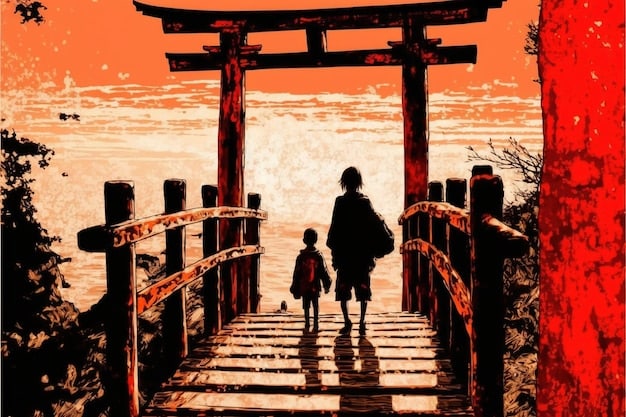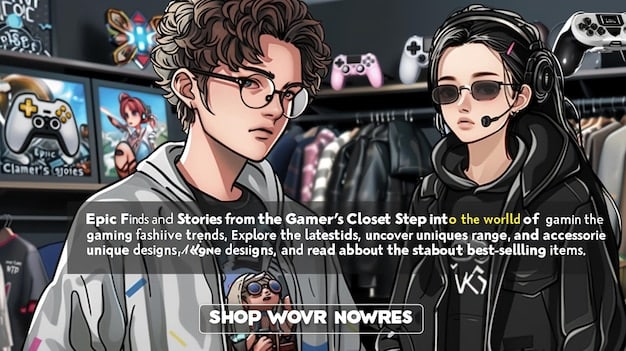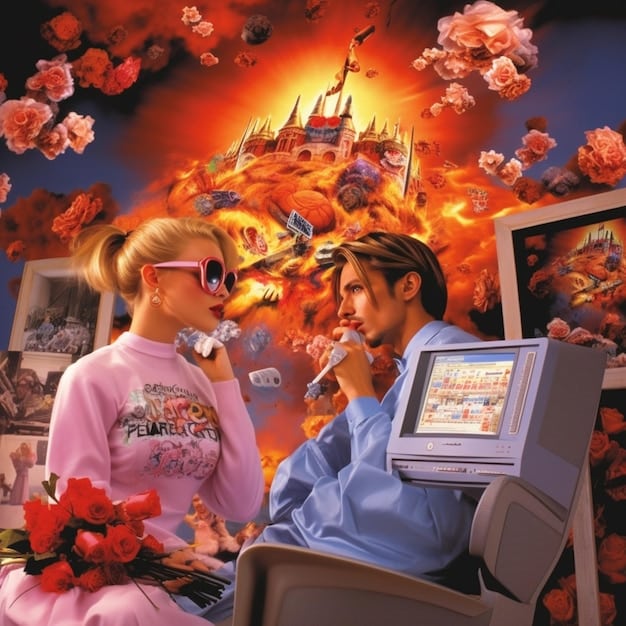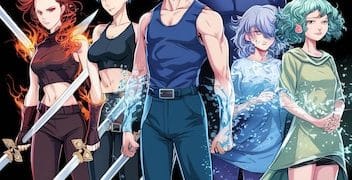Shonen Anime to Video Games: Spotting True Adaptations

Shonen anime and video game adaptations vary widely in their faithfulness to the original source material, with some capturing the essence and plot details while others take significant creative liberties.
The world of shonen anime and video games is vast and exciting, but how well do video game adaptations capture the spirit of their anime counterparts? Let’s explore which adaptations stay shonen anime and video games: Which adaptations stay true to the source material?.
Faithful Retellings vs. Creative Liberties
When it comes to adapting shonen anime into video games, developers face a critical decision: stick closely to the source material or venture into new, creative territory. This choice profoundly impacts the player experience and the overall reception of the game.
Some adaptations strive to be as faithful as possible, meticulously recreating iconic scenes, character arcs, and even minor plot details. These games aim to provide fans with an interactive experience that mirrors the anime they love.
The Allure of Authenticity
Faithful adaptations appeal to fans who crave a direct translation of their favorite series into a playable format. These games offer a sense of familiarity and nostalgia, allowing players to relive cherished moments and engage with the story in a new way.
The Risks of Deviation
On the other hand, some adaptations take significant liberties with the source material, introducing new characters, storylines, or gameplay mechanics. While this approach can lead to innovative experiences, it also risks alienating fans who expect a faithful representation of the anime.
- Staying true to key story arcs.
- Faithful character representation.
- Capturing the tone and spirit of the original work.

Ultimately, the success of an adaptation hinges on finding the right balance between faithfulness and creativity, respecting the source material while also delivering a compelling and enjoyable gaming experience. These decisions are key to how fans percieve the adaptations of their favorite franchises within shonen anime and video games: Which adaptations stay true to the source material? .
Dragon Ball Z: A Case Study in Adaptation
Dragon Ball Z is a prime example of a shonen anime that has seen numerous video game adaptations over the years. These games offer a wide spectrum of approaches, ranging from faithful retellings of the anime’s iconic sagas to original stories with unique gameplay mechanics.
One of the most critically acclaimed Dragon Ball Z adaptations is the Dragon Ball FighterZ, which captures the anime’s fast-paced action and over-the-top special moves with stunning visuals and a deep fighting system. The game closely follows the anime’s storyline.
Dragon Ball FighterZ: A Blend of Nostalgia and Innovation
Dragon Ball FighterZ stands out for its commitment to recreating the anime’s iconic battles and character interactions. The game features a roster of fan-favorite characters, each with their signature moves and transformations. This creates a great experience for fans.
Other DBZ Games: Exploring New Dimensions
While Dragon Ball FighterZ prioritizes faithfulness, other Dragon Ball Z games have experimented with original storylines and gameplay mechanics. Dragon Ball Xenoverse, for example, allows players to create their own custom characters and interact with the Dragon Ball universe in new ways.
- Dragon Ball Z: Kakarot – Faithful retelling of the DBZ saga.
- Dragon Ball FighterZ – Visually stunning and captures the essence of the series.
- Dragon Ball Xenoverse – Allows for character customization and original stories.
Thus, adaptations such as that of Dragon Ball Z in the realm of shonen anime and video games: Which adaptations stay true to the source material?, often tend to be a mixture between faithful storytelling and creating their own creative takes that fans can explore.

Naruto: Ninja Adventures Across Platforms
Naruto, another shonen anime juggernaut, has also been adapted into numerous video games across various platforms. These adaptations range from action-adventure titles that closely follow the anime’s plot to fighting games that emphasize competitive gameplay focusing on the core parts of the shonen anime.
The Naruto: Ultimate Ninja Storm series is a standout example of a successful anime adaptation. These games faithfully recreate the anime’s storylines, characters, and iconic battles, while also incorporating unique gameplay mechanics that complement the ninja theme.
Ultimate Ninja Storm: Reliving the Anime Experience
The Ultimate Ninja Storm games are known for their stunning visuals, fluid combat, and faithful recreation of the anime’s most memorable moments. Players can step into the shoes of Naruto and his friends as they progress through the series’ story arcs.
Aside from retelling the original story, the franchise also has offered different takes, characters and gameplay mechanics that are able to translate the spirit of the show quite well, such as “Naruto Shippuden: Ultimate Ninja Storm 4 – Road to Boruto”. With the franchise having plenty of adaptations, they all contribute to the legacy that makes up the Naruto games.
Exploring the Hidden Leaf Village
The Ultimate Ninja Storm games also feature expansive environments that allow players to explore the Hidden Leaf Village and other iconic locations from the anime. Discovering new areas and completing side quests adds depth to the overall experience.
Naruto provides an excellent example of how shonen anime and video games: Which adaptations stay true to the source material? can blend into their own identities, still maintaining key parts with innovative features of their own.
One Piece: Charting a Course for Adaptation
One Piece, the long-running shonen anime and manga series, has also made its mark in the world of video games. Adapting the vast and ever-expanding world of One Piece presents a significant challenge, but several games have successfully captured the spirit of adventure, camaraderie, and larger-than-life characters that define the series.
One notable adaptation is One Piece: Pirate Warriors, which combines the anime’s colorful world with Musou-style gameplay. Players take control of Luffy and his crew as they battle hordes of enemies across iconic locations from the series.
Pirate Warriors: A Swashbuckling Adventure
The Pirate Warriors games faithfully recreate the anime’s storylines, characters, and special moves, while also introducing unique gameplay mechanics that enhance the sense of scale and spectacle. Sailing the Grand Line and battling powerful foes adds depth to the overall experience.
The Grand Line Awaits
The Pirate Warriors games also feature expansive environments that allow players to explore iconic islands and seafaring locations from the anime, adding to the depth of the shonen anime and video games: Which adaptations stay true to the source material? question. Discovering new areas and completing side quests adds depth to the overall adventure.
- One Piece: Pirate Warriors – Combines the One Piece world with Musou-style gameplay.
- One Piece Odyssey – Introduces new characters and story elements.
- One Piece: World Seeker – An open-world adventure.
One Piece Odyssey is another entry that introduces new character and story elements. Other video game adaptations like One Piece: World Seeker gives players an open-world action adventure. These examples showcase the various ways that shonen anime and video games: Which adaptations stay true to the source material?.
Attack on Titan: Bravery in the Face of Giant Adaptations
Attack on Titan, the dark and intense shonen anime, has also seen video game adaptations that attempt to capture the series’ heart-pounding action and strategic combat. Translating the anime’s unique setting and themes into a playable format presents a unique set of challenges.
One of the most notable Attack on Titan adaptations is the Attack on Titan game by Koei Tecmo. These games closely follow the anime’s storylines, characters, and combat mechanics, while also introducing new elements that enhance the sense of immersion and danger.
Capturing the Thrill of Vertical Maneuvering
These Attack on Titan games are known for their faithful recreation of the anime’s vertical maneuvering gear, allowing players to swing through the air and engage in fast-paced combat with the Titans. Mastering the art of vertical maneuvering is essential for survival. This is important for shonen anime and video games: Which adaptations stay true to the source material?
Strategic Titan Combat
The Attack on Titan games also emphasize strategic combat, requiring players to carefully plan their attacks and target the Titans’ weak points. Coordinating with teammates and utilizing different weapon types adds depth to the overall experience. This also showcases the strategic elements that make up shonen anime and video games: Which adaptations stay true to the source material?.
Ultimately, this specific game provides a decent mix of translating the key elements that makes up Attack on Titan while also providing a great experience for newcomers as well as existing fans.
My Hero Academia: Being a Hero in Multiple Mediums
My Hero Academia, the popular shonen anime about a world where most of the population possesses superpowers, has also seen several video game adaptations. These adaptations range from action-packed fighters that emphasize the series’ unique Quirks to story-driven adventures that explore the world of heroes and villains.
One notable example is My Hero One’s Justice, which pits players against each other in over-the-top battles using the series’ iconic characters and their powerful Quirks. The game faithfully recreates the anime’s visual style and energy, providing an exciting and engaging experience for fans.
Unleashing Your Quirk
The My Hero One’s Justice games allow players to unleash their favorite characters’ Quirks in fast-paced battles. Mastering each character’s unique abilities and combos is key to victory. This is how shonen anime and video games: Which adaptations stay true to the source material? is implemented.
Becoming the Number One Hero
The games also feature a story mode that allows players to experience the anime’s major arcs from the perspective of both heroes and villains. Making choices and forming alliances adds depth to the overall narrative.
- My Hero One’s Justice – Fight other players in fast-paced combat.
- My Hero Academia: Ultra Rumble – Team-based battle royale game
Many other entries give players a wide variety of options should they wish for a team-based battle royale game for their take on the shonen anime and video games: Which adaptations stay true to the source material? experience, with additional content being added over time for players to enjoy. Overall, it gives fans a great translation of the world.
| Key Point | Brief Description |
|---|---|
| ⚔️ Faithful Adaptations | Closely follow the anime’s story, characters, and events. |
| ✨ Creative Liberties | Introduce new elements like original stories or gameplay. |
| 🕹️ Gameplay Diversity | Vary from fighting games to action-adventure, team-based and open-world. |
| 🤝 Fan Expectations | Success depends on balancing faithfulness and innovation for player enjoyment. |
FAQ
A faithful adaptation closely follows the original anime’s storyline, accurately portrays characters, and replicates key events, ensuring fans recognize and appreciate the source material.
Adaptations may introduce original stories or gameplay mechanics to provide a fresh experience, appeal to a broader audience, or overcome limitations of the game medium.
Dragon Ball FighterZ is often praised for its stunning visuals that captures the essence of the anime’s fight. Some also praise Dragon Ball Z Kakarot for retelling main sagas.
One Piece games often combine the anime’s colorful world with action-oriented gameplay like Musou-style combat, allowing players to explore islands and seafaring locations.
Balancing faithfulness with innovation is vital. It is important to respect the source material while delivering an enjoyable, accessible, and compelling gaming experience for players.
Conclusion
Ultimately, whether a shonen anime adaptation remains faithful to the source material or takes creative liberties depends on a variety of factors, including the developer’s vision, the target audience, and the limitations of the game medium. The most successful adaptations strike a balance between honoring the original work and delivering a compelling and enjoyable gaming experience.





